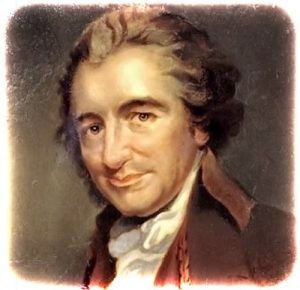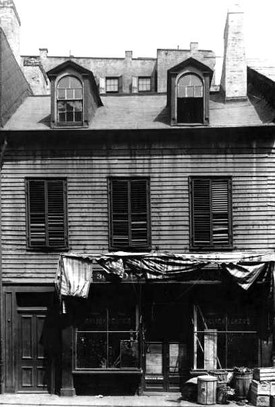Former Residence of Thomas Paine (Demolished)
Introduction
Text-to-speech Audio
Images
Thomas Paine

The Paine house as it appeared in 1914

Backstory and Context
Text-to-speech Audio
Thomas Paine was born in England in 1737. Much of his life was marked by hardship and failed business ventures, but in the early 1770s, Paine met Benjamin Franklin, who was then in London as part of his efforts to improve relations between the British and their colonies. Following an invitation by Franklin, Paine arrived in the colonies in 1774, just as the conflict between the Americans and the British was moving irrevocably toward war. In January of 1776, Paine published a 47-page pamphlet, Common Sense, which made a strong case for independence at a time when many colonists were still wavering on the issue.
Common Sense made Thomas Paine famous and a beloved figure among the American colonists. But the years after the American Revolution were difficult ones for him. He moved to France and supported the French Revolution, but during the Reign of Terror, he opposed the execution of Louis XVI. It was an unpopular move and led to Paine's nearly being executed on the guillotine. He was allowed to leave the country due to the intervention of James Monroe, who was then serving the American minister to France. When he returned to the United States, Paine was something of an outcast. The Founders were divided on the issue of the French Revolution, with some alarmed by the radical turn it took. Paine's reputation never fully recovered from his support of the revolutionaries. His well-known atheism did nothing to endear him to his adopted countrymen.
Paine settled in New York City in the early 1800s when he was old and in failing health. He lived in three different places in the city, including a modest rented residence at 309 Bleecker Street, which was then known as Herring Street. At the time, Greenwich was still very much a village and was very sparsely settled. Paine lived a quiet life, rarely leaving the home, although passers-by often noted seeing him at one of its windows.He died in 1809.
The home where Paine spent some of the last years of his life was demolished in the 1930s and a one-story store was built at the spot. That building would also demolished and replaced with another store, which stands on the site today.
Sources
Miller, Tom . The Lost Thomas Paine House at No. 309 Bleecker Street , Daytonian in Manhattan. November 12th 2012. Accessed November 15th 2020. http://daytoninmanhattan.blogspot.com/2012/11/the-lost-thomas-paine-house-no-309.html.
Apmann, Sarah Bean. Thomas Paine, the American Crisis, and Greenwich Village , Village Preservation. December 19th 2017. Accessed November 15th 2020. https://www.villagepreservation.org/2017/12/19/thomas-paine-the-american-crisis-and-greenwich-village/.
A Paine in the Village , Forgotten New York . May 1st 1999. Accessed November 15th 2020. https://forgotten-ny.com/1999/05/a-paine-in-the-village/.
